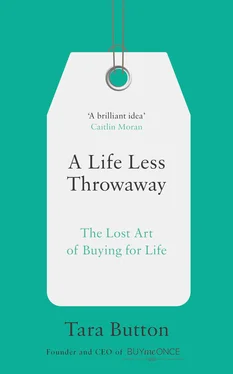If you’re reading this and thinking it’s as depressing as an empty toilet-roll holder, I apologise. It is depressing, but it’s also important to know what we’re up against, so we can know how to combat it. There’s a section at the end of this chapter on how to do just that.
MAKING IT UNFIXABLE – OBSOLESCENCE IN DISGUISE
One scorching August day in 2016, I invited my friend Tom Lawton over to look at toasters. Tom is a rather bizarre combination of engineer, inventor and TV presenter, and I set him the challenge of looking into how six different toaster brands were made and how that might affect their longevity.
‘What we’re looking for,’ Tom said, ‘is the weakest link. A product is only as good as its worst flaw.’
We looked at the toasters to get an insight into the choices that engineers have to make: the materials used, how a product is put together, and areas where the durability is being comprised. One of the things that immediately jumped out at us, though, was how hard these toasters were to get into. Some even had special star-shaped security screws. One did come apart eventually, exposing a jagged metal edge which cut Tom’s hand open. These toasters were clearly not designed to be taken apart.
Some manufacturers do this to protect themselves. If a member of the public fixes a product and it goes wrong, it can be a PR disaster for the brand, so you can see where this defensive thinking comes from. At the same time, being sold products that are designed to be unfixable (even by a trained engineer like Tom) has conditioned us to feel helpless when things break. So when their weakest link fails they are seen as ‘dead’ and destined for the big scrapheap in the sky (or sea … or slum).
Smartphones are perhaps the most notorious for this. Their weakest link is their battery, and the makers know it, but some of the brands make it impossible or prohibitively expensive for people to replace the battery. When it goes, often the whole phone goes. There’s been some backlash over this, but in general we’ve rolled over and accepted the situation. Perhaps seduced by having an excuse to buy the newest model?
But by preventing us from replacing the battery, the manufacturers are limiting the whole phone’s life to the life of the battery. Imagine your car tyres wearing out and the manufacturer telling you that you might as well buy a whole new car. This is essentially what many technology companies are doing right now.
Phones aren’t the only products that have come under fire recently either. A 2015 investigation into washing machines by Which? (the UK’s number one consumer magazine) showed their design had changed over time ‘and not for the better’. Now they’re made with the drum and bearings sealed inside, meaning that if the bearings go (one of the top five reasons for a breakdown), we have to replace the entire drum, which may cost around £200. If the machine’s out of warranty, we’ll generally be told it’s not worth fixing and we should buy a new one. 7
When manufacturers were asked why they now sealed in their drums, they claimed it made the machines more reliable. However, the most reliable brand, Miele, doesn’t seal its drums, so this excuse feels as suspicious to me as finding a feather in my cat’s bed. It’s clear something nasty has happened …
WHAT TO DO?
The emotional and financial toll of having something break on you is often not thought about, but whenever a vital product breaks it brings an added level of stress into your life. It can even trap low-income families into a cycle of poverty, forcing them to pay out again and again for shoddy appliances. Some might say that it is the duty of businesspeople to put profits first; however, as I sit here writing this in 2017, I would argue that to put profits before people and planet is dangerous, short-sighted, selfish and just plain rude. Fortunately, as consumers, we do have some power if we know how to use it.
When they build it to break
• Get angry and demand more. According to a report on product durability, when it comes to small appliances, we’re upset if something lasts less than three years and satisfied if it lasts 7.7 years. 8I think we should expect better. If something has a simple function, like to boil water or toast bread, there’s no excuse for it not to last for decades. The fact that we’re happy with less is worrying – we’ve been trained to expect poor longevity.
• Look out for petitions to change the law in your country. France already has a law to prevent planned obsolescence, and a director of any company caught in ‘built to break’ tactics can now go to jail for two years and face a fine of up to €300,000 or 5 per cent of the company’s revenue. I believe this should be the law worldwide, and I’ll be fighting to make that happen.
When it breaks
• Let us at BuyMeOnce know. We’re aiming to build up the biggest database in the world on how long products last.
• Tell the company that you’re dissatisfied and write an online review telling others how long that product lasted for you.
• Support your local fixers who still have the skills to mend things. We need more of these people.
• Have a go at mending yourself. ( See Appendix I: Care and Repair for advice. )
When buying
• Seek out products that are reviewed independently as lasting longer and those that come with the best warranties.
• Ask a local repairer which models they recommend.
• Buy locally whenever possible to avoid overseas factories with less rigorous standards.
• Vote for durability with your wallet by buying BuyMeOnce-approved products and we’ll soon see more companies upping their game.
• Ask how long a company keeps spare parts for and what the most common repair is, and consider buying that part in advance.
When they strip the quality
• Showing companies that you care about longevity is the key to getting it. Ask about it and talk about it on their social media. Be annoying! It’s often the best way to make change happen.
• Sign the BuyMeOnce pledge, letting companies know that you’d be willing to support them if they made products that were built to last. This will give them the confidence to change their policies.
• Look at independent reviews to see if the build quality has gone down. You can find these at Which? , Consumer Reports , the Reddit ‘Buyitforlife’ thread, BuyMeOnce and Amazon. Check the most up-to-date reviews for any evidence of fading quality. The good news is that people tend to be rather vocal when things don’t meet the standards they were expecting.
• Support innovative companies that want to do better. If you see a gap in the market, either consider filling it yourself, if you’re feeling inventive, or tell BuyMeOnce about it and we’ll put it out as a challenge.
• Support the makers and craftspeople who have a real connection to their products. Crowdfunding platforms such as Kickstarter help us because they allow engineers and makers to go straight to the customer without retailers or marketers in between. This means engineers who want to make longer-lasting products can offer them to the public, and if we like the idea, it may well get funded.
When they make their products unfixable
• Vote with your wallet and look for fixable modular versions of products. For example, a Fairphone can be taken apart and upgraded easily.
• If you have a product that needs fixing, visit your local Restart Project or Repair Café, or start your own group through online sites such as meetup or Facebook. If you haven’t repaired a product before, seek an expert’s advice first. Some products are perfectly repairable by a civilian; however, electricity is serious stuff, so do your homework and use parts approved by the manufacturer if possible. ( For more on repairs, see Appendix I: Care and Repair. )
Читать дальше












